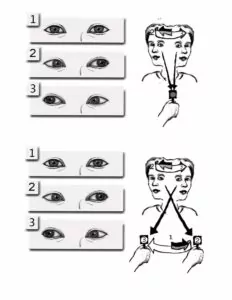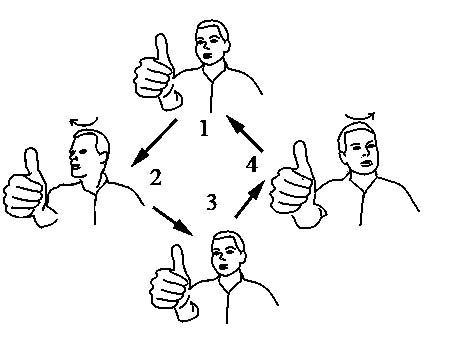vestibular exercises pdf nhs
Head exercises Gaze stabilization Target must remain in focus not blurry and appear stationary while head is in motion Perform exercise with little head movement 45º to either side of. Quickly lie down on your right-hand side.

Vestibular Rehabilitation Therapy Vrt Veda
Hold your arm out in front of you and put your thumb up.
. Extra Vestibular Rehabilitation Exercises Procedure Make sure you are seated safely before starting the exercises. We recommend that you complete your exercises three times a day if possible. Turn your head 45 degrees to the left or as far as is comfortable.
Allow about 20 minutes for each session and allow time for a rest afterwards. How to use the exercises. Remain in this position for 30 seconds or until any dizziness has.
However if your hearing is affected then. At first slow then quick a up and down b from side to side c focus on finger moving from 3ft to 1ft away from face 2 Head movements. Throw a ball from hand to hand under the knee.
Let symptoms subside plus seconds with each repetition. Vestibular assessment and typing up documentation Patient Patient knowledge ability to give a good history present symptoms ability to cope with assessment support system Log of symptoms diary Vestibular rehabilitation Relaxation exercises Patient information leaflets vestibular rehabilitation exercise booklet. Exercises A In bed 1 Eye movements.
Vestibular Ocular Reflex Exercise How to do the exercise Sit facing a blank wall about an arms length away from it. 122019 AAHC VertigoVestibular Vestibular Rehabilitation Exercises Level 1 page 2. Vestibular neuritis is inflammation of the vestibular nerve the nerve in the inner ear that sends messages to the brain.
The next set of exercises. Please be aware that for some exercises it may take a while for you to get used to it. Slowlyquickly move head rightleft with eyes openclosed.
Do not rush the exercises. The Brandt-Daroff exercises should be performed for two or three weeks and a suggested schedule is as follows Time exercise duration. You may find it helpful to complete your exercises at specific times each day.
Later with eyes closed. It is important to complete your exercises this often every day. Start sitting upright on the edge of the bed.
Move your head quickly as if saying no and keep your thumb in focus at all times. Sit up and turn your head back to a central position facing forwards. Use the table on page 12 to help you keep track of your exercises.
NHS Trust How to do the exercises 1. Vestibular compensation Vestibular compensation is a process that allows the brain to regain. In a sitting position bend your head down to look at the floor then up to look at the ceiling.
Please do all six movements 2-3 times each day. Perform the standing exercises with no shoes on or with flat-heeled shoes. Keeping your thumb nail in focus turn your head from side to side.
At first slow then quick. Lie down on your right side. Exercises to improve standing balance.
Ad Find Deals on vestibular exercises in Sports Fitness on Amazon. Vestibular Rehabilitation is an exercise-based programme to encourage the nervous system to compensate for problems in the inner ear. A bend backwards and forwards b turn from side to side B Sitting 1 and 2 - as above.
The exercises you will be shown and taught by the physiotherapist are designed to re-programme your brain to tune-out the dizzy sensations. Position tilt head down 30º. Throw a ball from hand to hand above eye level.
How difficult should my exercises feel. In section A the exercises should be done with eyes open. Stop and wait for symptoms to resolve about 30 seconds.
Begin with level 1. Eye and head movement exercises. Do sessions per day.
Activities that promote Vestibular input Swings linear or rotation Sitting in a Rocking chair Gaming style floor chair Spinning chair Balance board Yoga especially inversion poses Hanging upside down this can be achieved at the park swinging from a tree branch. Following a thorough examination a specialist Physiotherapist will develop a personalised home exercise programme for you. The management plan may include.
Vestibular Rehabilitation Exercises Level 1. Should this exercise make you feel off balance dizzy or unstable practice this level for the remainder of the 10 minutes. As they are designed to challenge your balance system you may feel some.
The symptoms of vestibular neuritis and labyrinthitis are very similar. Do not overdo the. Let symptoms subside plus seconds with each repetition.
Repeat this 10 times. Lead your head with your eyes focusing on the floor and the ceiling. Brighton and Sussex University Hospitals and Western Sussex Hospitals have joined up to form a new NHS Foundation Trust for our area.
Be careful when you start to move after you have completed the exercises. Around when you exercise. You might find that your dizziness problems get worse for a few days after you start the exercises but you should persevere with them.
Remain in this position for 30 seconds or until you no longer feel dizzy. Repeat times per session. The exercises will bring on your symptoms but in a very controlled way.
Labyrinthitis is inflammation of the labyrinth a maze of fluid-filled channels in the inner ear. Do not perform the exercises more strenuously or vigorously than you. They succeed in 95 of cases but more arduous than the Epley manoeuvre.
Vestibular rehab exercises pdf nhs Saturday April 2 2022 Edit. Your vestibular rehabilitation exercises are designed to make you experience mild. This is essential to the re-programming and if you do not bring on the dizziness at all the exercises will not work.
The exercises should be performed for approximately 10 minutes twice daily. Cawthorne-Cooksey Vestibular Exercises Section A. Change from a sitting to a standing position with eyes open then closed please note this is not advised for the elderly with postural hypertension C.
In all other sections exercises should be carried out five times with eyes open and five times with eyes shut. As a general rule you should build up gradually from one set of exercises to the next. Do the exercises one two or three times a day.
Eye head and shoulder movements as 1 and 2. Vestibular Rehabilitation Exercises Level 2. Ad Find out how to treat vertigo from the comfort of home with incredible remedies.
Brandt-Daroff exercises These exercises are a method of treating Benign Paroxysmal Positional Vertigo BPPV. Exercises A In bed 1 Eye movements. Repeat entire process 2.
You can keep using this website for information about our services but to find out more about our new Trust and all our hospitals please visit wwwuhsussexnhsuk. You should perform the exercises daily for the most benefit. At home with an internal door.
Turn your head 45 degrees to the left or as far as is comfortable.
:max_bytes(150000):strip_icc()/cervical-radiculopathy-physical-therapy-5199243_final-01-a732057be7c14ac0a3be1a7dc75325f0.jpg)
Cervical Radiculopathy Physical Therapy What To Expect

Home Vestibular Exercises Youtube

Wrist Exercises Jointpainrelief Wrist Exercises Hand Therapy Exercises Hand Therapy

Vestibular Rehabilitation Therapy Vrt Veda

11 Exercises For Ataxia Patients National Ataxia Foundation

Vor Exercise Gaze Stabilisation Exercises Ear Balance And Eustachian Tube

Post Exertional Malaise Mepedia

Evidence Based Program Otago Exercise Program

Vestibular Rehabilitation Exercises Pi 1209 Pdf Vertigo Nervous System

Stroke Wise Hand Exercises Hand Therapy Finger Exercises Hand Therapy Exercises

Vestibular Rehabilitation Exercises Brain Spine Foundation

Brain Spine Foundation Vestibular Rehabilitation Exercises

Vestibular Therapy 7 Reasons It Doesn T Work Dr Kim Bell Dpt
